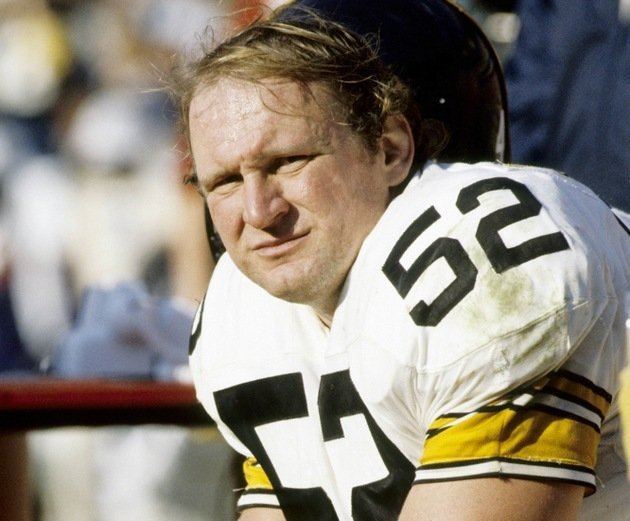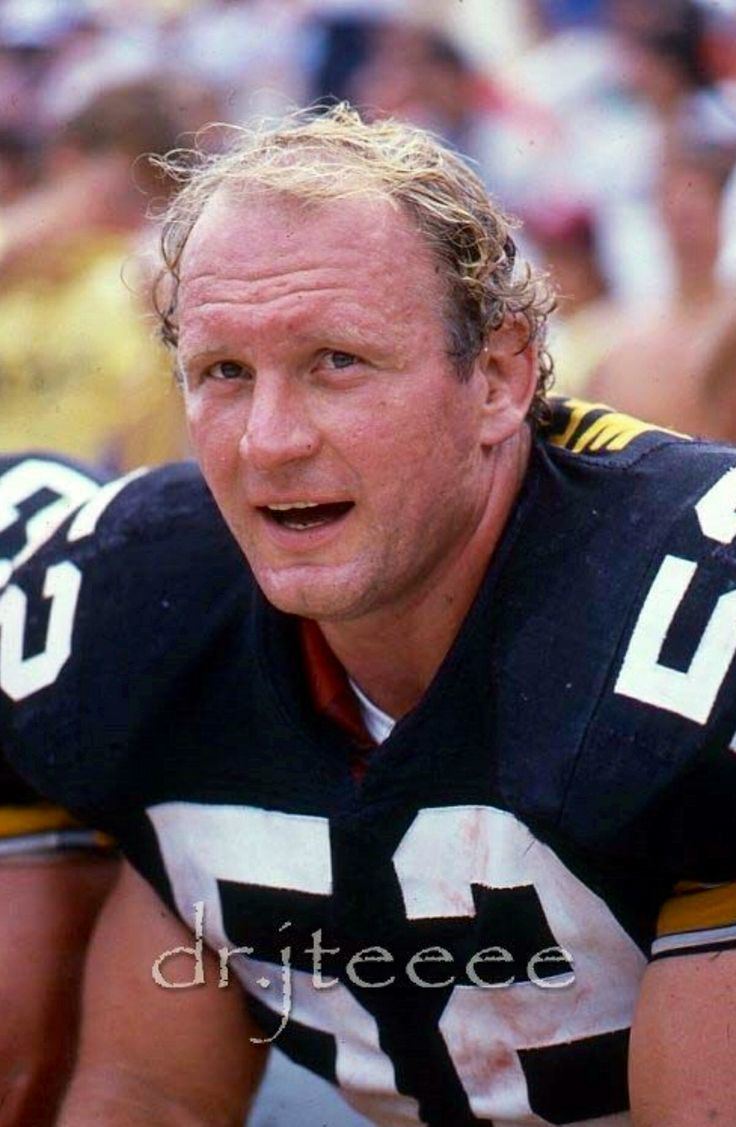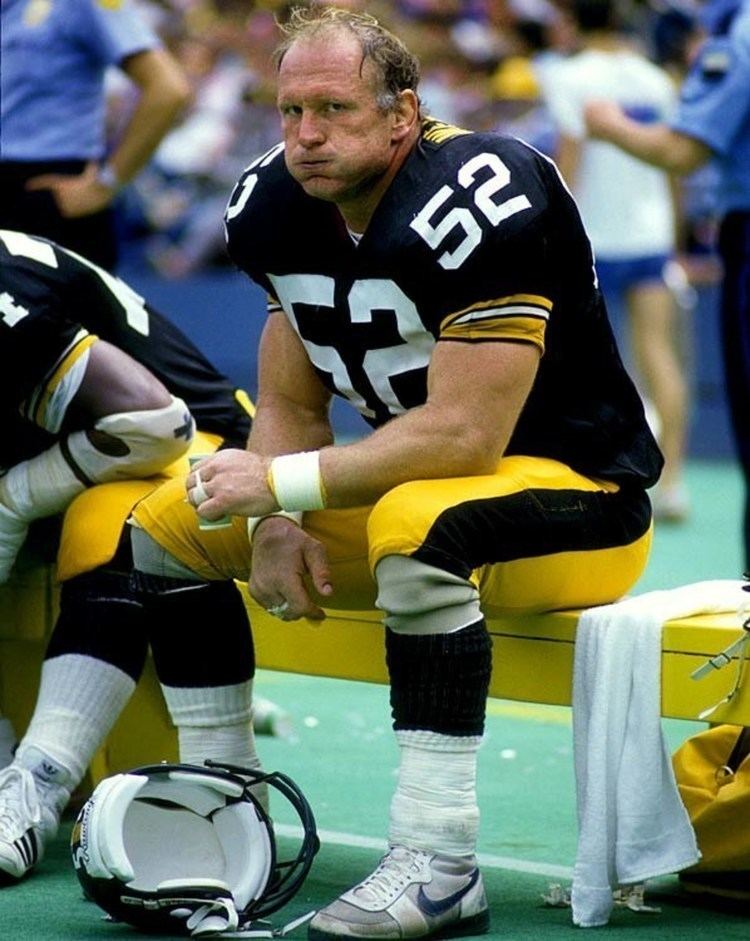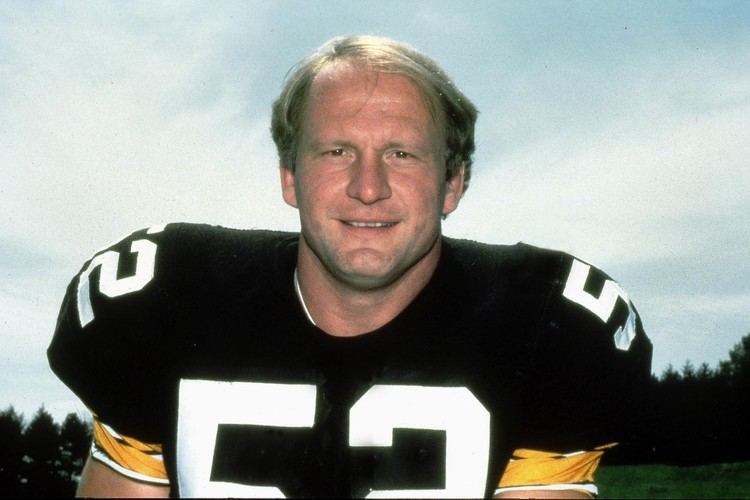Position: Center Height 1.86 m | Weight: 255 lb (116 kg) Spouse Pamela Name Mike Webster Siblings Reid, Joe | |
 | ||
Date of birth: (1952-03-18)March 18, 1952 Date of death: September 24, 2002(2002-09-24) (aged 50) Place of death: Pittsburgh, Pennsylvania Children Hillary, Colin, Garrett, Brooke Similar People | ||
Iron mike webster patient zero in the nfl s league of denial part 1 of 9 frontline
Michael Lewis Webster (March 18, 1952 – September 24, 2002) was an American football player who played as a center in the National Football League from 1974 to 1990 with the Pittsburgh Steelers and Kansas City Chiefs. He is a member of the Pro Football Hall of Fame, class of 1997. Nicknamed "Iron Mike", Webster anchored the Steelers' offensive line during much of their run of four Super Bowl victories from 1974 to 1979 and is considered by some as the best center in NFL history.
Contents
- Iron mike webster patient zero in the nfl s league of denial part 1 of 9 frontline
- Mike webster movie
- Football career
- Retirement and legacy
- Post football life
- Ailments
- Lawsuit
- References

Webster was the first former NFL player diagnosed with chronic traumatic encephalopathy (CTE). Since his death, he has become a symbol for head injuries in the NFL and the ongoing debate over player safety. His doctors were of the opinion that multiple concussions during his career damaged his frontal lobe, which caused cognitive dysfunction.

Webster died at the age of 50 of a heart attack.

Mike webster movie
Football career

Mike Webster was regarded as the best center in the Big Ten during most of his career at the University of Wisconsin. At 6-foot-1, 255 pounds, he was drafted in the 5th round of the 1974 NFL Draft by the Pittsburgh Steelers. Serving as a backup at center and guard for two years while being mentored by veteran center Ray Mansfield, Webster became the team's starting center in 1976, where he would remain for 150 straight games until 1986. These years included four Super Bowl wins by the Steelers, and Webster and Terry Bradshaw are consequently one of the most well-known center–quarterback pairs in history. Webster was honored as an All-Pro seven times and played in the Pro Bowl nine times. An avid weightlifter, Webster was known for playing with bare arms to keep opponents from grabbing his sleeves. Webster is also perhaps the best-known of a long line of All-Pro centers for the Steelers. From 1964 to 2006, just four men started at that position: Mansfield, Webster, Dermontti Dawson, and Jeff Hartings. In his last year in Pittsburgh, Webster returned the favor by mentoring the then-rookie Dawson in the same manner Mansfield mentored Webster earlier in his career.
Retirement and legacy
Webster was a free agent after 1988 season. He was signed by the Kansas City Chiefs, who initially made him an offensive line coach before allowing him to return as the starting center. His career ended after the 1990 season, with a total of 245 games played at center. At the time of his retirement, he was the last active player in the NFL to have played on all four Super Bowl winning teams of the 1970s Steelers. He played more seasons as a Steeler than anyone else in franchise history (15 seasons), one season ahead of Hines Ward.
While, at the time of his retirement, the Steelers were no longer officially retiring jerseys, Webster's No. 52 has not been reissued by the team since he retired. In 1999, he was ranked number 75 on The Sporting News' list of the 100 Greatest Football Players. The football stadium at Rhinelander High School, his alma mater, is named Mike Webster Stadium in his honor. Webster was elected to the Wisconsin Athletic Hall of Fame in 2007.
Post-football life
Webster was proven to have been disabled before retiring from the NFL. After retirement, Webster suffered from amnesia, dementia, depression, and acute bone and muscle pain. He lived out of his pickup truck or in train stations between Wisconsin and Pittsburgh, even though his friends and former teammates offered to rent apartments for him. In his last years Webster lived with his youngest son, Garrett, who though only a teenager at the time, moved from Wisconsin to Pittsburgh to care for his father. Webster's wife Pamela divorced him six months before his death in 2002 of a heart attack at age 50.
Webster's body was cremated and the ashes were divided among his wife and their four children.
Ailments
After death, Mike Webster was diagnosed with chronic traumatic encephalopathy (CTE), a neurodegenerative disease. Webster was the first former NFL player diagnosed with CTE. Bennet Omalu, a forensic neuropathologist, examined tissue from Webster and eight other NFL players and determined they all showed the kind of brain damage previously seen in people with Alzheimer's disease or dementia, as well as in some retired boxers. Omalu's findings were largely ignored by the NFL until Cincinnati Bengals wide receiver Chris Henry was diagnosed with CTE shortly after his death at age 26 in 2009. Webster's son Garrett now serves as the administrator to the Brain Injury Research Institute in Pittsburgh, which is dedicated to encouraging individuals who have suffered from head trauma to donate their brains after death as well as being an advocate to players who have similar conditions that his father had.
It has been speculated that Webster's ailments were due to wear and tear sustained over his playing career; some doctors estimated he had been in the equivalent of "25,000 automobile crashes" in over 25 years of playing football at the high school, college and professional levels. His wife Pamela would state years later that she felt that she caused Webster's change in personality in the years before his death and placed guilt on herself over her decision to divorce Webster, until discovering after his death about the CTE diagnosis. At the time of his death, Webster was addicted to prescription medication.
Nicknamed "Iron Mike", Webster's reputation for durability led him to play even through injuries. Contrary to rumors, Webster never admitted to using anabolic steroids during his career, even though they were legal at the time.
His struggle with mental illness, as a result of CTE, at the end of his life was featured in the 2015 film Concussion. Webster was portrayed by David Morse and Dr. Omalu was portrayed by Will Smith.
Lawsuit
Webster's estate brought a lawsuit in Maryland's U.S. District Court against the National Football League. The estate contended that Webster was disabled at the time of his retirement, and was owed $1.142 million in disability payments under the NFL's retirement plan. On April 26, 2005, a federal judge ruled that the NFL benefits plan owed Webster's estate $1.18 million in benefits. With the addition of interest and fees, that amount was estimated to exceed $1.60 million. The NFL appealed the ruling. On December 13, 2006, the U.S. Court of Appeals for the Fourth Circuit in Richmond, Virginia, affirmed the Baltimore federal judge's 2005 ruling that the league's retirement plan must pay benefits reserved for players whose disabilities began while they were still playing football.
